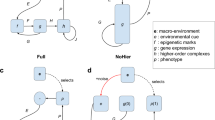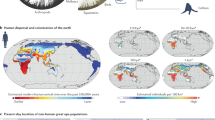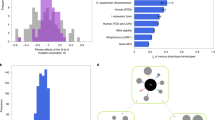Abstract

There has been a recent trend in evolutionary developmental biology (evo–devo) towards using increasing numbers of model species. I argue that, to understand phenotypic change and novelty, researchers who investigate evo–devo in animals should choose a limited number of model organisms in which to develop a sophisticated methodological tool kit for functional investigations. Furthermore, a synthesis of evo–devo with population genetics and evolutionary ecology is needed to meet future challenges.
This is a preview of subscription content, access via your institution
Access options
Subscribe to this journal
Receive 12 print issues and online access
$189.00 per year
only $15.75 per issue
Buy this article
- Purchase on Springer Link
- Instant access to full article PDF
Prices may be subject to local taxes which are calculated during checkout
Similar content being viewed by others
References
Wilkins, A. The Evolution of Developmental Pathways (Sinauer Associates, Sunderland, Massachusetts, 2002).
Rudel, D. & Sommer, R. J. The evolution of developmental mechanisms. Dev. Biol. 264, 15–37 (2003).
Raff, R. The Shape of Life (Chicago Univ. Press, Chicago, 1996).
Gerhard, J. & Kirschner, M. Cells, Embryos and Evolution (Blackwell Science, Oxford, 1997).
Minelli, A. The Development of Animal Form (Cambridge Univ. Press, Cambridge, 2003).
Carroll, S. B. Endless Forms Most Beautiful (Norton & Comp., New York, 2005).
Harvey, P. H. & Pagel, M. D. The Comparative Method in Evolutionary Biology (Oxford Univ. Press, Oxford, 1991).
Jenner, R. J. & Wills, M. A. The choice of model organisms in evo–devo. Nature Rev. Genet. 8, 311–319 (2007).
Rieppel, O. Development, essentialism, and population thinking. Evol. Dev. 10, 504–507 (2008).
Lynch, M. The Origin of Genome Architecture (Sinauer Associates, Sunderland Massachusetts, 2007).
Akam, M., Holland, P., Ingham, P. & Wray, G. (eds) The Evolution of Developmental Mechanisms. Development Supplement (The Company of Biologists, Cambridge, 1994).
Roth, S. & Hartenstein, V. Development of Tribolium castaneum. Dev. Genes Evol. 218, 115–118 (2008).
Lynch, J. A., Brent, A. E., Leaf, D. S., Pultz, M. A. & Desplan, C. Localized maternal orthodenticle patterns anterior and posterior in the long germ wasp Nasonia. Nature 439, 728–732 (2006).
Hong, R. L. & Sommer, R. J. Pristionchus pacificus: a well-rounded nematode. BioEssays, 28, 651–659 (2006).
Cooke, J., Nowak, M. A., Boerlijst, M. & Maynard-Smith, J. Evolutionary origin and maintenance of redundant gene expression during metazoan development. Trends Genet. 13, 360–364 (1997).
Veeman, M. T., Axelrod, J. D. & Moon, R. T. A second canon: functions and mechanisms of β-catenin-independent Wnt signaling. Dev. Cell 5, 367–377 (2003).
Dieterich, C. et al. The Pristionchus pacificus genome provides a unique perspective on nematode lifestyle and parasitism. Nature Genet. 40, 1193–1198 (2008).
Schlager, B. et al. Molecular cloning of a dominant Roller mutant and establishment of DNA-mediated transformation in the nematode model Pristionchus pacificus. Genesis (in the press).
Sternberg, P. W. Vulva development. Wormbook [online], 25 Jun 2005 (doi:10.1895/wormbook.1.6.1)., ed.
Sommer, R. J. & Sternberg, P. W. Apoptosis limits the size of the vulval equivalence group in Pristionchus pacificus: a genetic analysis. Curr. Biol. 6, 52–59 (1996).
Schlager, B. et al. HAIRY-like transcription factors and the evolution of the nematode vulva equivalence group. Curr. Biol. 16, 1386–1394 (2006).
Tian, H ; Schlager, B., Xiao, H. & Sommer, R. J. Wnt signaling by differentially expressed Wnt ligands induces vulva development in Pristionchus pacificus. Curr. Biol. 18, 142–146 (2008).
Tribolium Genome Sequencing Consortium. The genome of the model beetle and pest Tribolium castaneum. Nature 452, 949–955 (2008).
Roth, S. in Gastrulation: From cells to embryos (ed. C. Stern) 105–122 (Cold Spring Harbor Laboratory Press, 2004).
Rushlow, C. & Levine, M. Role of the zerknüllt gene in dorsal-ventral pattern formation in Drosophila. Adv. Genet. 27, 277–307 (1990).
van der Zee, M., Berns, N. & Roth, S. Distinct functions of the Tribolium zerknüllt genes in serosa specification and dorsal closure. Curr. Biol. 15, 624–636 (2005).
Stathopoulos, A., Van Drenth, M., Erives, A., Markstein, M. & Levine, M. Whole-genome analysis of dorsal-ventral patterning in the Drosophila embryo. Cell 111, 687–701 (2002).
da Fonseca, R. N. et al. Self-regulatory circuits in dorsoventral axis formation of the short-germ beetle Tribolium castaneum. Dev. Cell 14, 605–615 (2008).
Wagner, G. The developmental genetics of homology. Nature Rev. Genet. 8, 473–479 (2007).
Sommer, R. J. Homology and the hierarchy of biological systems. BioEssays, 30, 653–658 (2008).
de Beer, G. R. Embryos and Ancestors (Claredon Press, Oxford, 1958).
de Beer, G. R. Homology: An Unsolved Problem (Oxford Univ. Press, Oxford, 1971).
Behringer, R. et al. (eds) Emerging Model Organisms. A Laboratory Manual (Cold Spring Harbor Laboratory Press, 2009).
Reddien, P. W. & Sanchez, Alvarado, A. Fundamentals of planarian regeneration. Annu. Rev. Cell Dev. Biol. 20, 725–757 (2004).
Tiozzo, S., Brown, F. D. & De Tomaso, A. W. in Stem Cells From Hydra to Man (ed. Thomas Bosch) 95–112 (Springer, Heidelberg, 2008).
Amundson, R. The Changing Role of the Embryo in Evolutionary Thought (Cambridge Univ. Press, Cambridge, 2005).
Dobzhansky, T. Evolution, Genetics and Man (Wiley, New York, 1955).
Mayr, E. Animal Species and Evolution (Harvard Univ. Press, Cambridge, Massachusetts, 1966).
Kimura, M. The Neutral Theory of Molecular Evolution. (Cambridge Univ. Press, Cambridge, 1983).
Zauner, H. & Sommer, R. J. in Evolving pathways: Key Themes in Evolutionary Developmental Biology (eds Minelli, A. & Fusco, g.). 151–171 (Cambridge Univ. Press, Cambridge, 2008).
Zauner, H. & Sommer, R. J. Evolution of robustness in the signaling network of Pristionchus vulva development. Proc. Natl Acad Sci. USA 104, 10086–10091 (2007).
Milloz, J., Duveau, F., Nuez, I. & Felix, M.-A. Intraspecific evolution of the intercellular network underlying a robust developmental system. Genes Dev. 22, 3064–3075 (2008).
Palopoli, M. F. et al. Molecular basis of the copulatory plug polymorphism in Caenorhabditis elegans. Nature 454, 1019–10222 (2008).
Reddy, K. C., Andersen, E. C., Kruglyak, L. & Kim, D. H. A polymorphism in npr-1 is a behavioral determinant of pathogen susceptibility in C. elegans. Science 323, 382–384 (2009).
Nordborg, M. & Weigel, D. Next-generation genetics in plants. Nature 456, 720–723 (2008).
Gilbert, S. F. & Bolker, J. A. Ecological developmental biology: preface to the symposium. Evol. Dev. 5, 3–8 (2003).
Herrmann, M., Mayer, E. W. & Sommer, R. J. Nematodes of the genus Pristionchus are closely associated with scarab beetles and the Colorado potato beetle in western Europe. Zoology 109, 96–108 (2006).
Herrmann, M. et al. The nematode Pristionchus pacificus (Nematoda: Diplogastridae) is associated with the Oriental beetle Exomala orientalis (Coleoptera: Scarabaeidae) in Japan. Zool. Sci. 24, 883–889 (2007).
Sokoloff, A. The Biology of Tribolium (Oxford Clarendon, Oxford, 1972).
Hong, R. L., Svatos, A., Herrmann, M. & Sommer, R. J. The species-specific recognition of beetle cues by Pristionchus maupasi. Evol. Dev. 10, 273–279 (2008).
Hong, R. L., Witte, H. & Sommer, R. J. Natural variation in P. pacificus insect pheromone attraction involves the protein kinase EGL-4. Proc. Natl Acad. Sci. USA 105, 7779–7784 (2008).
Jackowska, M. et al. Genomic and gene regulatory signatures of cryptozoic adaptation: loss of blue sensitive photoreceptors through expansion of long wavelength-opsin expression in the red flour beetle Tribolium castaneum. Front. Zool. 4, 24 (2007).
Darling, J. et al. Rising starlet: the starlet sea anemone Nematostella vectensis. BioEssays 27, 211–221 (2005).
Jeffery, W. R. Cavefish as model system in evolutionary developmental biology. Dev. Biol. 231, 1–12 (2001).
Pigliucci, M. Evolution of phenotypic plasticity: where are we going now? Trends Ecol. Evol. 20, 481–486 (2005).
West-Eberhard, M. J. Developmental Plasticity and Evolution (Oxford Univ. Press, Oxford, 2003).
Saenko, S. V., French, V., Brakefield, P. M. & Beldade, P. Conserved developmental processes and the formation of evolutionary novelties: examples from butterfly wings. Philos. Trans. R. Soc. Lond., B 363, 1549–1555 (2008).
Laforsch, C. & Tollrian, R. Embryological aspects of inducible morphological defense in Daphnia. J. Morph. 262, 701–707 (2004).
Abouheif, E. & Wray, G. Evolution of the gene network underlying wing polymorphism in ants. Science 297, 249–252 (2002).
Van Valen, L. Festschrift. Science 180, 488 (1973).
Hoekstra, H. E. & Coyne, J. A. The locus of evolution: evo devo and the genetics of adaptation. Evolution 61, 995–1016 (2007).
Lynch, M. The frailty of adaptive hypotheses for the origins of organismal complexity. Proc. Natl Acad Sci. USA 104, 8597–8604 (2007).
Hill, R. C. et al. Genetic flexibility in the convergent evolution of hermaphroditism in Caenorhabditis hermaphrodites. Dev. Cell 10, 531–538 (2006).
Shapiro, M. D. et al. Genetic and developmental basis of evolutionary pelvic reduction in threespine sticklebacks. Nature 428, 717–723 (2005).
Corley, S. B., Carpenter, R., Copsey, L. & Coen, E. Floral asymmetry involves an interplay between TCP and MYB transcription factors in Antirrhinum. Proc. Natl Acad Sci. USA 102, 5068–5073 (2005).
Acknowledgements
I would like to thank S. Roth, F. Brown, M. Riebesell and three anonymous reviewers for useful comments on the manuscript.
Author information
Authors and Affiliations
Related links
Related links
DATABASES
Entrez Genome
FURTHER INFORMATION
Rights and permissions
About this article
Cite this article
Sommer, R. The future of evo–devo: model systems and evolutionary theory. Nat Rev Genet 10, 416–422 (2009). https://doi.org/10.1038/nrg2567
Issue Date:
DOI: https://doi.org/10.1038/nrg2567
This article is cited by
-
Onthodiplogaster japonica n. gen., n. sp. (Rhabditida: Diplogastridae) isolated from Onthophagus sp. (Coleoptera: Scarabaeidae) from Japan
Scientific Reports (2023)
-
Analysis of repeat elements in the Pristionchus pacificus genome reveals an ancient invasion by horizontally transferred transposons
BMC Genomics (2022)
-
Tribolium beetles as a model system in evolution and ecology
Heredity (2021)
-
Comparative genomics and community curation further improve gene annotations in the nematode Pristionchus pacificus
BMC Genomics (2020)
-
Feeding Dimorphism in a Mycophagous Nematode, Bursaphelenchus sinensis
Scientific Reports (2019)



